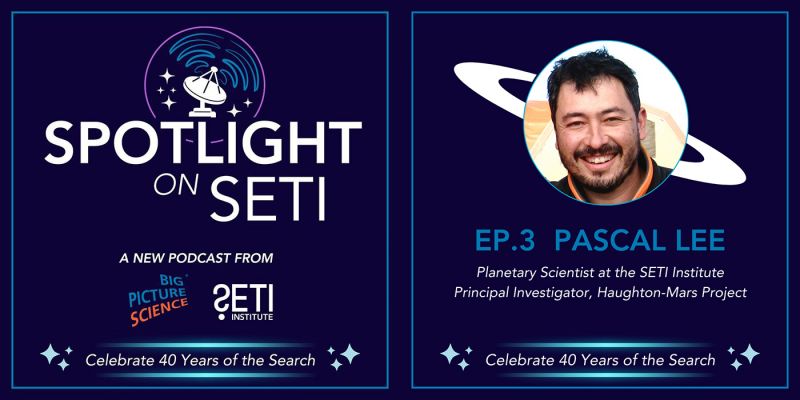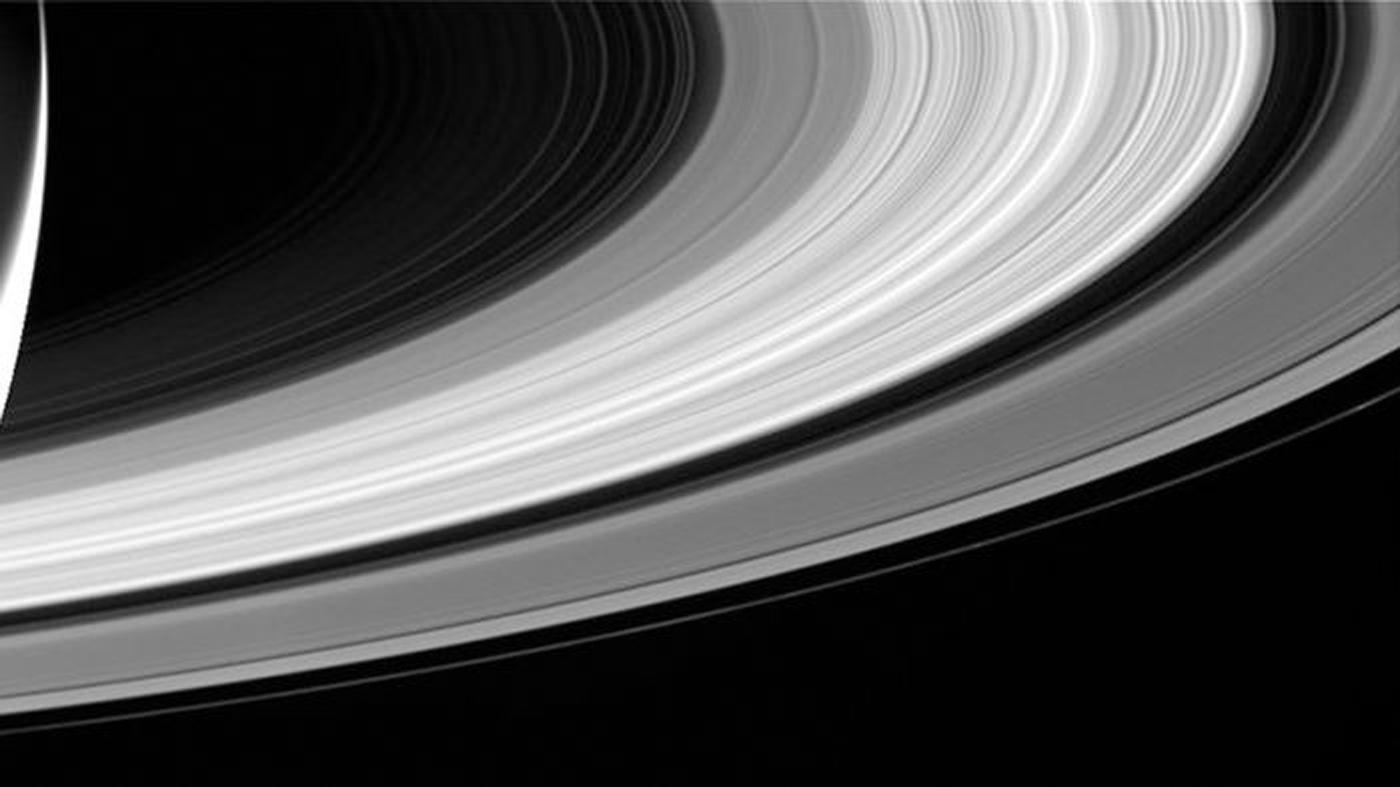
Summer vacations notwithstanding, August was active for SETI Institute researchers and staff. Download the report
Some highlights include:
- 10 peer-reviewed articles published or accepted for publication. Topics include:
- Discontinuous drainage systems formed by highland precipitation and ground-water outflow in the Navua Valles and southwest Hadriacus Mons regions, Mars (Icarus)
- Goldstone and Arecibo radar observations of (99942) Apophis in 2012–2013 (Icarus)
- The ESO Diffuse Interstellar Bands Large Exploration Survey: EDIBLES I. Project description, survey sample and quality assessment (Astronomy and Astrophysics)
- Evidence that the Directly-Imaged Planet HD 131399 Ab is a Background Star(Astronomical Journal)
- See the report for more here
- The work of SETI Institute scientists has been or will be featured at several important scientific conferences and events including:
- Lunar and Planetary Institute Building New Worlds Conference (August 2017)
- European Planetary Science Congress (September 2017)
- Division of Planetary Sciences Conference (October 2017)
- American Geophysical Union Fall Meeting (December 2017)
- SETI Institute scientists and press were featured in popular media including:
- Scientific American
- NBC News
- Science News
- Many SETI Institute scientists offered both formal and informal talks and presentations before, during and after the solar eclipse on August 21.
- SETI Talks resumed in August at the new home at SRI International Headquarters. The August talk featured the class of 2017 Research Experience for Undergraduates (REU) students.
- Frontier Development Lab 2017 (FDL) concluded with team presentations at Intel.
- Peter Tennenbaum received the 2017 NASA Ames Honor Award for Contractor Employee.
- The SETI Institute expedition flag was returned from the Arctic and is now at the SETI Institute.
On September 15 Cassini ended its 20-year mission with a dramatic plunge into Saturn’s atmosphere. Cassini spent 13 years in orbit around Saturn and as a result we have amassed a wealth of knowledge about Saturn, its rings, moons and weather. We know that at least two of its moons, Titan and Enceladus have the potential for life.
SETI Institute scientist Matt Tiscareno has been studying the images and data from Cassini since 2004 and his particular expertise is in planetary rings. Some of Cassini’s images of Saturn’s rings showed hidden structures in the rings that otherwise seem to have the same density and composition. “It’s like how an ice cube has a different texture from a snowball,” said Matt to Science Magazine. “There are hints it may have to do with the structure in the planet.”
One of the last images Cassini captured was of the propellers in the outermost rings of Saturn that show up when moonlets disrupt the rings. We don’t see the moon in these images, but, said Matt to New Scientist, “the moon is as small as a pixel, so we don’t really see it, but we see the disturbance.” He added, “We can’t go back in time and see our solar system when it was forming, but Saturn can give us a window into some of these processes.”
Matt is also featured discussing Cassini in the NOVA episode, “Death Dive to Saturn”.
- NOVA: Death Dive to Saturn
- Science: After a Dive into Saturn, Cassini Spacecraft Melts into History
- New Scientist: Cassini Takes a Last Look at the Ring Patterns Made by Mini Moons
- The Ringer: “Something Special is Happening”: Cassini’s Scientists Honor Their Favorite Photos
- Space.com: Styx Sings Touching Farewell to Cassini Probe Before It Crashes into Saturn
Uranus is the seventh planet from the Sun and has the coldest planetary atmosphere – along with Neptune, it is known as one of the “ice giants.” It also has a system of thin rings and 27 known moons. In new article accepted for publication in the Astronomical Journal, lead author Robert Chancia, researchers discovered that Uranus’ Eta ring is not circular, but triangular, and that is the cause of a distortion in the small moon, Cressida. As result, the team was not only able to measure the mass and density of Cressida, but also to predict that Cressida will imminently (within the next million years) collide with another moon, probably Desdemona.
These are not the first two moons of Uranus to face future collision. Research from SETI Institute scientists Mark Showalter and Robert French in 2012 determined that the moons Belinda and Cupid will collide sometime between 10 and 1,000 million years from now.
- Astronomy Magazine: Uranus is a Dangerous Place for its Moons
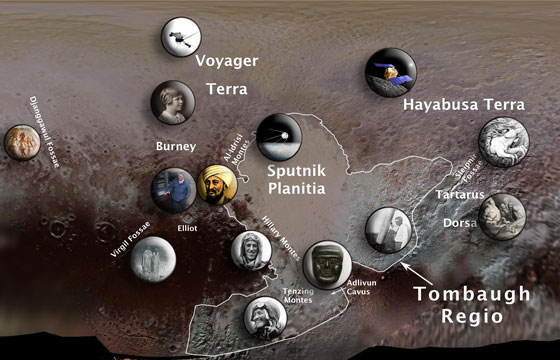 Pluto – First Official Names Unveiled
Pluto – First Official Names UnveiledThe International Astronomical Union (IAU) announced the first official names for 14 places on Pluto last week. Among the chosen names were mountain ranges -- Hillary Montes and Tenzing Montes -- named for Sir Edmund Hillary and Tenzing Norgay, the first men known to summit Mount Everest. In total, 14 geological features on Pluto were named.
The New Horizons Nomenclature Working Group, including SETI Institute scientists Mark Showalter and Ross Beyer, collaborated with the SETI Institute and the IAU on the “Our Pluto” online naming campaign, inviting the public to propose names.
The New Horizons probe that was launched in 2006, with a primary mission of a flyby study of the Pluto system. Its secondary mission is to study Kuiper belt objects. Its next flyby will be of Kuiper Belt object 2014 MU69 and will take place in January 2019.
- SETI.org: Pluto Features Given First Official Names
- New Zealand Herald: It’s Official: Pluto Mountains Named After Sir Ed
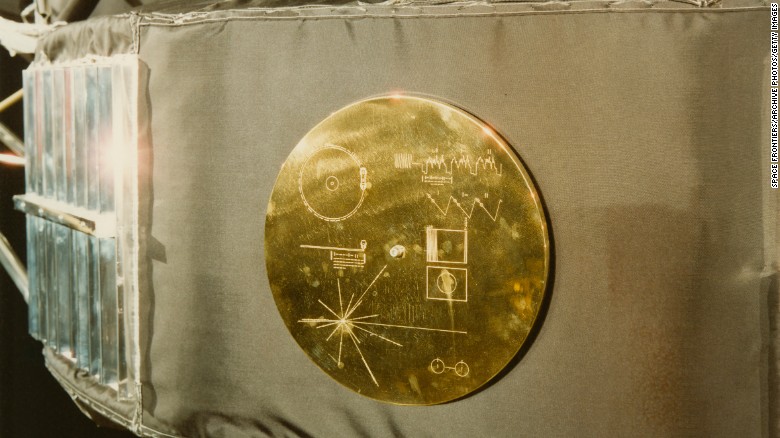 Voyager, The Golden Record and Frank Drake
Voyager, The Golden Record and Frank DrakeAs the two Voyager space probes travel further and further into interstellar space 40 years after launch, here on Earth we remain fascinated with the Golden Record and what was on it.
The Golden Record is a gold-plated copper disc that includes a wide array of music, natural sounds, human greetings, images and printed messages intended to represent the diversity of humanity and human culture. The contents of the Golden Record were determined by the Interstellar Record Committee which was chaired by Carl Sagan and included the SETI Institute’s Frank Drake.
- Facebook Live: A Conversation with Frank Drake
- Nashville Public Radio: Bach Goes Interstellar: Classical Music on NASA’s Golden Record, 40 Years Later
- CNN: Voyager’s Golden Record Still Plays On
- Space.com: Dear E.T.: Math on Voyager’s Golden Record Tells a Story
- Boing Boing: How to Decode the Images on the Voyager Golden Record
- Fox News Science: Aliens Could Learn About us from Math on Voyager’s Golden Record
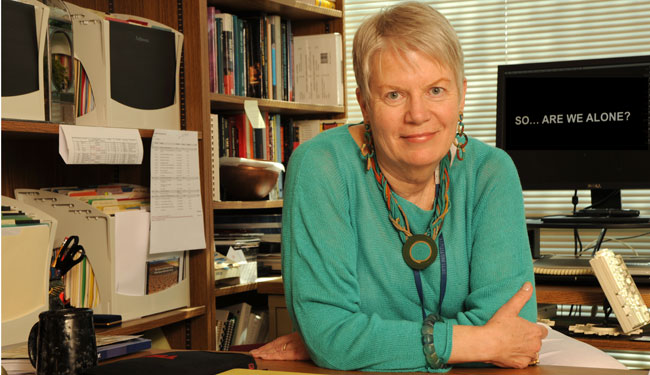 Jill Tarter on the Radio (or Podcast)
Jill Tarter on the Radio (or Podcast)Jill Tarter, Bernard M. Oliver Chair for SETI at the SETI Institute and member of the Board of Trustees was on Science Friday to discuss her life’s work. She also appeared with author Sarah Scoles on the Cited podcast to talk about Sarah’s book, Making Contact: Jill Tarter and the Search for Extraterrestrial Intelligence.
 Big Picture Science
Big Picture ScienceLast week, Plan of a Hack, looks at hacking of yore, before it there were computers and before it was criminal. This week, in hacking part deux, Angles of a Hack considers modern variations.
- European Planetary Science Conference: September 17-22, Riga, Latvia SETI Institute Scientist Matt Tiscareno will present research on the planetary rings of Saturn and the Cassini mission.
- NightHowl, September 23, San Francisco, CA Franck Marchis will demonstrate the Unistellar telescope
- Great Conversations at the Ontario Science Centre, September 27, Toronto, Canada Jill Tarter will speak on A Cosmic Perspective: Searching for Aliens and Finding Ourselves.
- Menlo Park Library Science Night, September 28, Menlo Park, CA SETI Institute scientist Margaret Race will take part in the Menlo Park Library’s annual science night.
- G.I.R.L. (Girl Scouts Convention), October 6-8, Columbus, OH Pamela Harman will participate in a panel discussion and share information about the SETI Institute’s work to develop space science badges for the Girl Scouts.
- Silicon Valley Astronomy Lecture Series: October 11, Los Altos Hills, CA Jill Tarter will offer a free public lecture, Discovering Life Beyond Earth.
- East Bay Astronomical Society: October 14, Oakland, CA Franck Marchis will deliver a talk, The Search for a Cousin of Earth: Science or Fiction?
- Division of Planetary Sciences, October 15-20, Provo, UT SETI Institute Scientist Matt Tiscareno is a featured speaker who will present research on the planetary rings of Saturn and the Cassini mission. Other SETI Institute scientists whose work will be featured at the conference include Christina Dalle Ore, Melissa McGrath, Mark Showalter, Franck Marchis, Driss Takir, Robert Morris, Matija Cuk, Ross Beyer, David Hinson, Erin Ryan, and Peter Tenenbaum.
- American Geophysical Union: December 11-15, New Orleans, LA SETI Institute Scientist Matt Tiscareno will present research on the planetary rings of Saturn and the Cassini mission.

